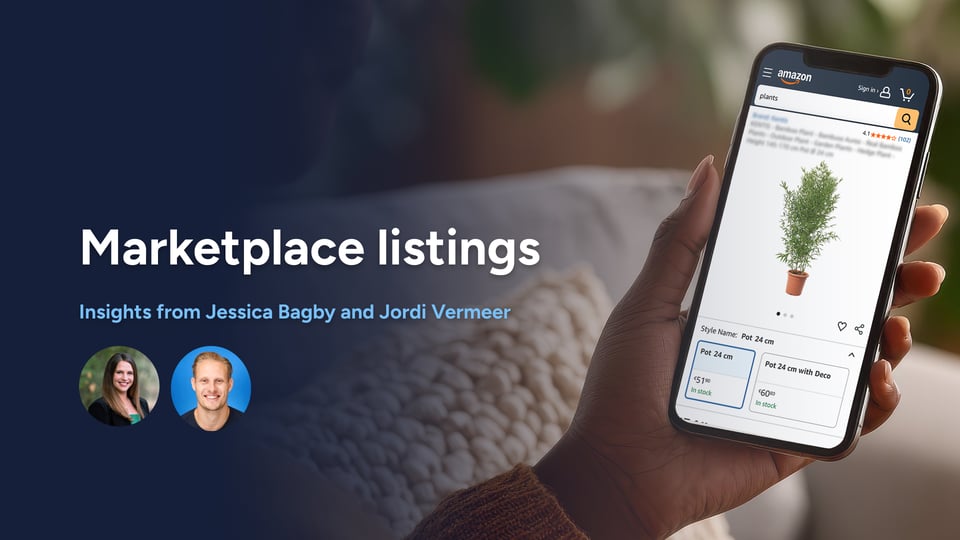If you have ever launched on a new marketplace and thought “we’re live, job done,” you already know what comes next: silence, slow sales, or worse, a flood of returns. The truth is simple. Getting listed is table stakes. Growth comes from deliberate, repeatable optimization.
When it comes to marketplace operations, this playbook shows you how to fix what matters first, then scale. It’s built from a real conversation between ChannelEngine's Matt Tomaszewski (Partnerships, North America), Jordi Vermeer (VP of Revenue, North America), and Sitation's Jessica Bagby (Senior Director of Managed Services), who shared their firsthand insights from helping brands succeed on marketplaces every day.
The “5W” framework that keeps teams focused
Before you touch a title or toggle a dynamic repricer, answer five questions for each initiative:
- Who are we optimizing for? Shoppers, but also the marketplace’s search and category teams.
- What product set is in scope? Start with your top 20 percent SKUs by revenue or potential.
- When did items go live, and when will we refresh? Set a cadence up front.
- Where are product listings published? Each marketplace has unique rules and filters.
- Why this batch now? Tie work to a business goal such as conversion lift, lower returns, or faster expansion.
Lock those answers first, then move.
Step 1: Nail the PDP basics that drive discovery and conversion
If you are live, your Product Detail Page (PDP) must be rock solid. Basics are not boring. They are the difference between page 5 and page 1.
See it in action
Just launched on a marketplace? The first 90 days matter most. Before you think about scaling, make sure your foundation is rock solid.
Watch as our experts break down the essential first steps: how to fix what’s live, tighten your PDPs, and set yourself up for growth fast.
- Title optimization: Include primary keywords in the order that the marketplace search actually reads. Some retailers give outsized weight to titles compared to bullets or descriptions. Know the rule for each channel and write accordingly.
Check out: How to write product titles that sell on every marketplace - Attributes and filters: Complete every spec the marketplace exposes to shoppers. Filters like size, color, material, or compatibility decide whether you even appear in results.
- Images that answer questions: Infographics and callouts that highlight dimensions, materials, or technical features reduce doubt and returns.
- Compliance and length limits: Max out what is allowed without truncation. Meet category style guides to avoid suppression.
Step 2: Prove it on a small scale
Do not “optimize everything.” Test what works, then multiply.
- Pick one marketplace where you already have some traction.
- Select a small pilot set of high-priority SKUs.
- Run side-by-side tests for 30 to 60 days. For example, compare “baseline content” versus “search-driven content plus new visuals.”
- Track a tight metric set: impressions, click-through rate, conversion rate, sales, and return rate.
- Decide like a scientist: keep the winners, drop the noise.
The idea sounds simple: test before you scale. But what does that really look like in practice?
Watch this short conversation where our experts share real experiences of brands learning to optimize step by step - and what happens when they don't.
Step 3: Expand without chaos
Scaling from one to many marketplaces is where teams burn out. Avoid that.
- Lay the plumbing first: Centralize feeds, inventory sync, order flows, and error handling so testing new channels takes hours, not weeks.
- Sequence your rollout: Start with categories that match strong demand and reasonable SKU density on each marketplace.
- Understand channel strategy:
- Invitation-only marketplaces may take longer to onboard, yet competition is lower, and there is no buy box fight.
- Amazon requires harder-working content and ads, plus strict operational performance.
- Social commerce often rewards affiliate seeding and samples to creators. Content and community drive demand.
See what success looks like
Real-world proof that testing pays off. In this clip, our experts share examples of brands that made small, targeted optimizations and saw dramatic gains: from doubling conversion rates to cutting return rates through clearer PDP content.
Step 4: Automate the work that steals your time
Your team should spend time improving growth levers, not moving excel columns around. With the right platform in place, you can streamline marketplace operations end-to-end, from listing updates to repricing and reporting, without adding more manual work.
ChannelEngine’s automation for marketplace operations helps brands reduce human error, speed up listing syncs, and keep every channel aligned. It connects your catalog, pricing, and fulfillment data so you can scale without losing control.
- Automated error handling and alerts: Catch listing rejections and schema mismatches fast.
- Repricing within rules: A guard-railed dynamic repricer can raise contribution margin without constant monitoring.
- Reporting that speaks human: Standardize dashboards for sales, return rates, buy box share, and content health so everyone sees the same truth.
Step 5: Build a refresh cadence you can actually keep
Optimization is not a one-time project. It is a calendar.
- Quarterly cycles work: Month 1 - select SKUs and research. Month 2 - produce and publish. Month 3 - measure and document the learning.
- Scope tightly: Titles, bullets, and descriptions in one cycle. Images and A+ content in the next.
- Close the loop: Use return reasons and review text to fix clarity gaps. If shoppers think “refurbished” means “new,” say “refurbished” clearly in the title and bullets. Returns drop. Margins recover.
Optimization never stops
This isn’t a one-and-done project. In this closing conversation, our experts share how top brands build repeatable systems for marketplace optimization: balancing cadence, automation, and AI to keep performance climbing quarter after quarter.
Don't ignore AI-driven discovery
More buyers are starting product research on AI assistants. That means two things for your brand:
- Great content everywhere: If your product data and messaging are consistent and present across many reputable endpoints, AI systems have more reliable signals to surface you.
- Entity clarity and coverage: Clear, machine-readable attributes, rich descriptions, and real customer proof all increase your odds of being recommended.
Learn how this connects to the rise of agentic commerce, where AI doesn’t just recommend but acts on behalf of shoppers.
Your 30-day starter plan
- Week 1: Choose one marketplace, 10 to 20 SKUs, define success metrics, pull current rank, and return data.
- Week 2: Rewrite titles and bullets with search data, complete attributes, and refresh the image set with two infographic callouts per SKU.
- Week 3: Enable core automations: error alerts, inventory sync checks, and a conservative repricer test.
- Week 4: Publish, monitor daily, document wins and misses, then queue the next batch.
Download the Fix it Fast guide to uncover 16 proven marketplace optimizations that drive real results.

 Jessica Bagby
Jessica Bagby Jordi Vermeer
Jordi Vermeer


